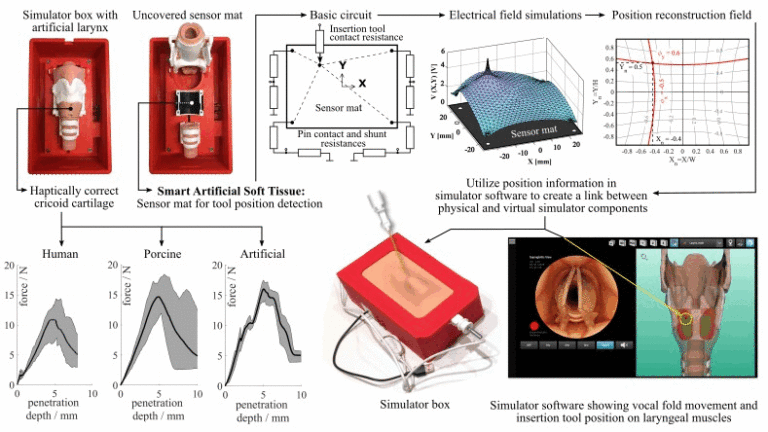Surgical simulators are safe and evolving educational tools for developing surgical skills. In particular, virtual and hybrid simulators are preferred due to their detailedness, customization and evaluation capabilities. To accelerate the development of a novel class of hybrid simulators, a “Smart Artificial Soft Tissue” sensor is presented here, that determines the relative position of electrically stimulated surgical instruments on soft tissue-like materials while providing realistic haptic feedback.
This sensory tissue imitation is based on soft, elastic, and conductive carbon-black-silicone composites, which makes it much more cost-effective compared to other commonly used optical or electromagnetic tracking systems. Position detection of electrically stimulated surgical instruments on the synthetic tissue is achieved by inverse resistance mappings. Without the need for a fixed reference point, the position is determined relatively between embedded electrodes and surgical instrument. The application of optimized algorithms reduces hardware requirements significantly. This is particularly beneficial for highly deformable structures when specific target regions need to be reached or avoided. The carbon-black-silicone composite used can be shaped almost arbitrarily and its elasticity can be tuned by modifying the silicone base material. Thus, objective positional feedback for haptically correct artificial soft tissue can be ensured.
The “Smart Artificial Soft Tissue” is demonstrated by the development of a laryngeal phantom to simulate the implantation of laryngeal pacemaker electrodes. Apart from the position-detecting larynx phantom with correct haptics proven by measurements of human specimens, the simulator uses a mobile computer for the virtual representation of the vocal folds’ movements, in accordance with the electrical stimulation by the inserted electrodes. The possibility of displaying additional information about target regions and anatomy is intended to optimize the learning progress and illustrates the extensibility of hybrid surgical simulators.

